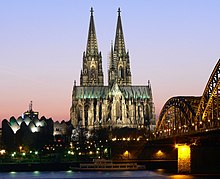Architecture of Germany
[7] Starting with the Linear Pottery culture circular enclosures and long houses, the biggest buildings of their time, were erected in Germany, from around 5.000 BC.Some, like the Heuneburg, the oldest city north of the Alps,[9] grew to become important cultural centres of the Iron Age in Central Europe, that maintained trade routes to the Mediterranean.This combines elements of the Roman triumphal arch (arch-shaped passageways, half-columns) with the vernacular Teutonic heritage (baseless triangles of the blind arcade, polychromatic masonry).The Romanesque period, from the 10th to the early 13th century, is characterised by semi-circular arches, robust appearance, small paired windows, and groin vaults.It is the only Gothic church tower in Germany that was completed in the Middle Ages (1330), and survived the bombing raids of November 1944, which destroyed all of the houses on the west and north side of the market.The method of construction, used extensively for town houses of the Medieval and Renaissance periods, (see Dornstetten, illustrated above) lasted into the 20th century for rural buildings.Examples include the decorated inner courtyard of Trausnitz Castle and the ducal Landshut Residence in the inner city, built by Italian Renaissance master craftsmen.In Wolfenbüttel, the castle of the Guelphs and the Evangelical town church Beatae-Maria-Virginis are worth mentioning as special examples of the Renaissance.The Baroque architecture of the German government royal and princely houses was based on the model of France, especially the court of Louis XIV at Versailles.Examples are the Zwinger Palace in Dresden, built by Matthäus Daniel Pöppelmann from 1709 to 1728, initially for the holding of court festivals.An important example is the Würzburg Residence with the Emperor's Hall and the staircase, whose construction began under the leadership of Johann Balthasar Neumann in 1720.Other examples of Baroque church architecture are the Basilica of the Vierzehnheiligen in Upper Franconia and the rebuilt Frauenkirche in Dresden, created by George Bähr between 1722 and 1743.It was created in the late 18th century under the regency of Duke Leopold III of Anhalt-Dessau (1740–1817), after returning from a Grand Tour to Italy, the Netherlands, England, France and Switzerland which he had taken together with his architect friend Friedrich Wilhelm von Erdmannsdorff.The Brandenburg Gate in Berlin, commissioned by King Frederick William II of Prussia as a sign of peace and completed by Carl Gotthard Langhans in 1791, is arguably one of the most famous monuments of classicism in Germany.Leo von Klenze (1784–1864) was a court architect of Bavarian King Ludwig I, another prominent representative of the Greek Revival style.Ludwig's passion for Hellenism inspired the architectural style of von Klenze, who built many neoclassical buildings in Munich, including the Ruhmeshalle and the Monopteros in the Englischer Garten.Drawing from traditional German printmaking, the style uses precise and hard edges, an element that was rather different from the flowing lines seen in Art Nouveau elsewhere.Henry Van de Velde, who worked most of his career in Germany, was a Belgian theorist who influenced many others to continue in this style of graphic art including Peter Behrens, Hermann Obrist, and Richard Riemerschmid.The style is commonly summed up in four slogans: ornament is a crime, truth to materials, form follows function, and Le Corbusier's description of houses as "machines for living".The so-called "classical modernism" in Germany is essentially identical to the Bauhaus, founded by Walter Gropius in 1919, shortly after he had succeeded Henry van de Velde in Weimar as Director of the Arts and Crafts School.In 1927, one of the first and most defining manifestations of the International Style was the Weissenhof Estate in Stuttgart, built as a component of the exhibition "Die Wohnung," organized by the Deutscher Werkbund, and overseen by Mies van der Rohe.The fifteen contributing architects included Mies, and other names most associated with the movement: Peter Behrens, Le Corbusier, Walter Gropius, J.J.P.The fiercely discussed reconstruction efforts after the war varied considerably between East and West Germany, and between individual cities.There is a recent trend in the 21st century in many German cities to resume reconstruction work and New Classical architecture in core areas.

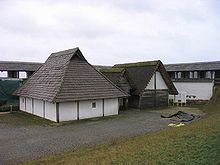
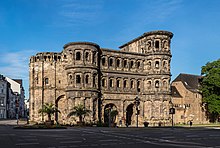

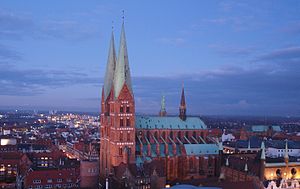







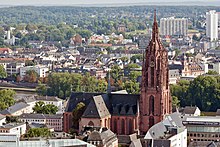
Frankfurt CathedralGothicRömerold townNeoclassicalPaulskircheModernistPostmodernistFrankfurt skylineBrandenburg GateBerlinPostmodernCarolingianRomanesqueRenaissanceBaroqueClassicalModernInternational Styleprincipalitiesvernacular architectureheterogeneousWorld War IIMunichCologne CathedralSt. Paul's Church (Frankfurt am Main)Neuschwanstein CastleHambach CastleWartburgReichstag buildingBilzingslebenHomo heidelbergensiscircular enclosureslong housesUnetice cultureLeubingen tumulusBronze AgeUrnfield cultureBell BeakerUneticeTumulus culturesNordic Bronze AgeHallstatt cultureIron AgeLa Tène cultureHeuneburgMediterraneanItalic peoplesLatinsRomansPorta NigraRoman EmpireFederal Republic of GermanyAncient Romeboundaries of the Roman Empirethermaeamphitheatresthermal spasAula PalatinaCarolingian architectureOttonian architecturePalatine Chapel, AachenCharlemagnePre-RomanesqueMerovingianCarolingian RenaissanceLorsch AbbeyAbbey Church of St. Michael'sBishopBernward of HildesheimBenedictinemonasteryOttonian (Early-Romanesque) styleOttonian RenaissanceemperorsSaxon DynastyOtto IOtto IIOtto IIIRomanesque architectureList of regional characteristics of Romanesque churchesSpeyer Cathedraltwelve Romanesque churches of CologneSalian dynastySt. Michael's Church in HildesheimSaxony-AnhaltLimburg CathedralSt. ServatiusQuedlinburgLuebeck CathedralBrunswick CathedralSt. Mary's CathedralSt. MichaelHildesheimTrier CathedralNaumburg CathedralBamberg CathedralMaulbronn AbbeyCistercian architectureBrick GothicGothic architecturemedieval periodLiebfrauenkircheOur dear LadyFreiburg Cathedraldukes of ZähringenJacob BurckhardtMilan CathedralBeauvais CathedralSt. Mary's ChurchLübeckGermanyGermanNorthern EuropeNorthern GermanyBaltic SeabricksStralsundRostockWismarGreifswaldSzczecinKołobrzegGdańskguild housesbourgeoisie



